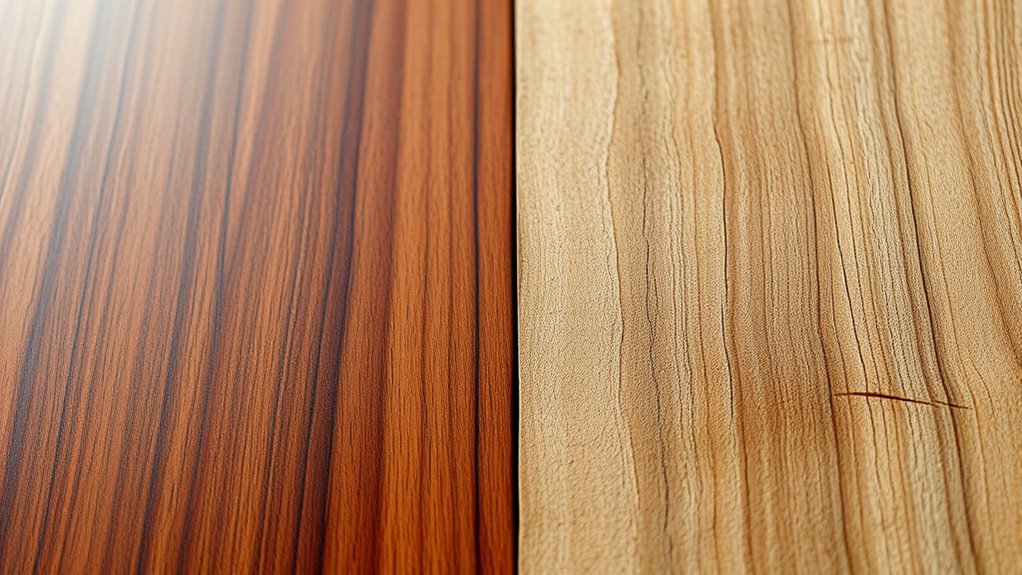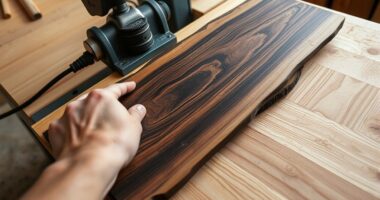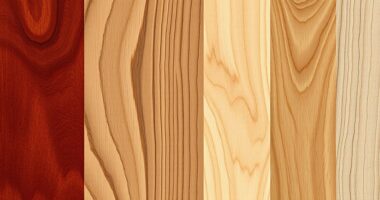Hardwoods come from angiosperms with broad leaves, grow slower, and are denser, making them ideal for furniture and flooring. Softwoods, from conifers, grow faster, are lighter, and easier to work with, often used in construction and outdoor projects. Hardwoods typically look more intricate and durable, while softwoods are simpler and more affordable. To understand which suits your needs best, explore the differences further—you’ll find the details quite insightful.
Key Takeaways
- Hardwoods come from angiosperms with broader leaves; softwoods derive from gymnosperms with needle-like leaves.
- Hardwoods grow slower, are denser, and generally more durable; softwoods grow faster and are lighter.
- Hardwood grain patterns are intricate with visible pores; softwoods have simpler, lighter-colored grains.
- Softwoods are easier to work with and more cost-effective; hardwoods require more effort but offer better finish and longevity.
- Softwoods support sustainable forestry due to quick growth; hardwoods are better suited for high durability applications despite slower growth.
Origins and Botanical Differences
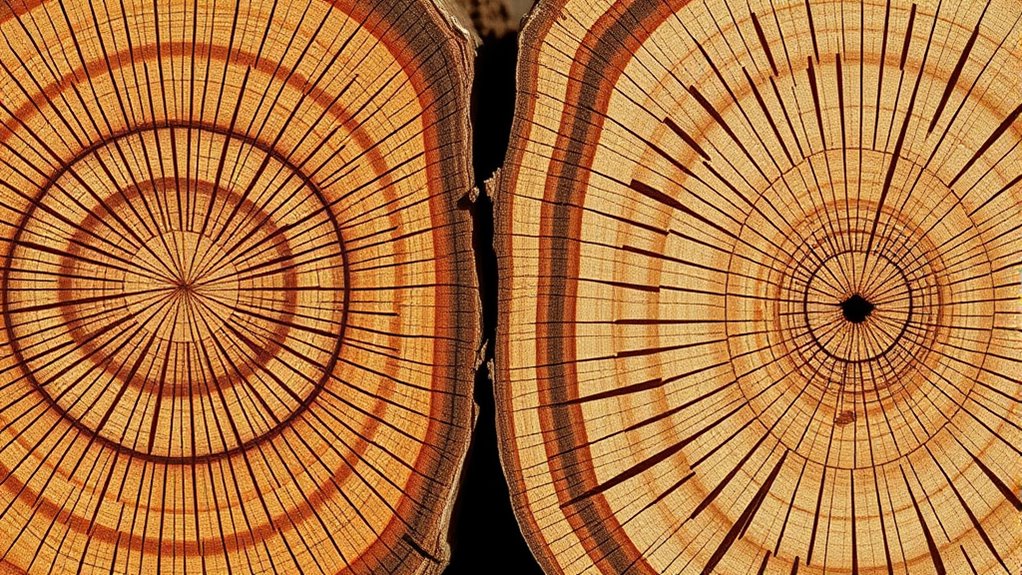
Have you ever wondered what sets hardwoods apart from softwoods at a botanical level? Hardwoods come from angiosperms, which include both monocots and dicots, and are typically characterized by broad leaves. These trees reproduce by producing seeds enclosed in fruits or nuts and are often deciduous, shedding leaves seasonally.
In contrast, softwoods originate from gymnosperms, mainly coniferous trees, which have needle-like leaves and produce seeds on cones. Their seeds are exposed, not enclosed, and they rely on wind for pollination.
Hardwood trees, like oak and rosewood, tend to grow slower and develop denser timber, while softwoods such as pine and cedar grow faster and are easier to process. These botanical differences reflect their distinct evolutionary paths and adaptions to their environments.
Cell Structure and Physical Properties
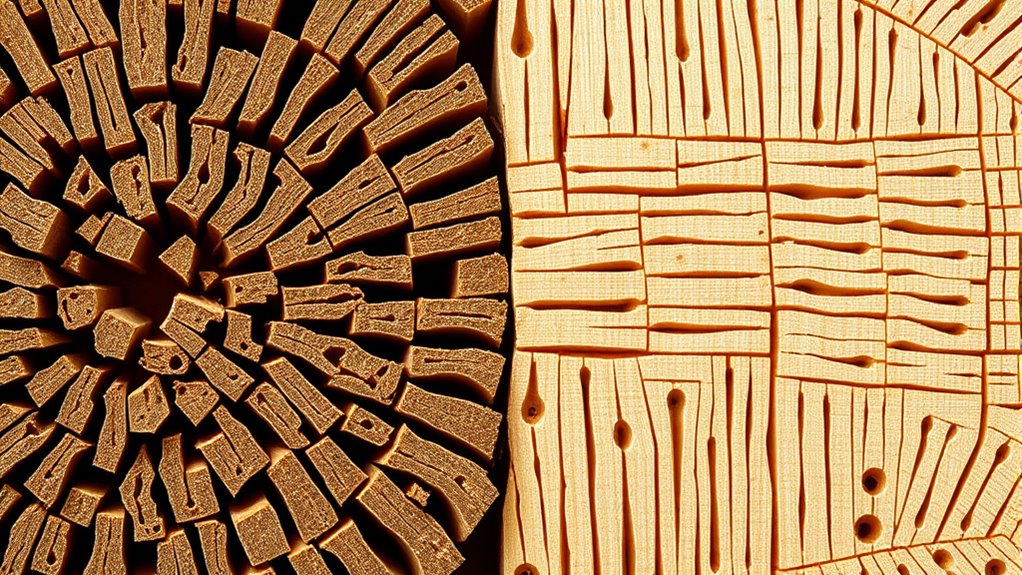
The cellular makeup of hardwoods and softwoods directly influences their physical properties and how they perform in various applications. Hardwoods contain multiple cell types, including vessels, fibers, parenchyma, and rays, creating a complex structure. These vessels are visible pores that transport water and nutrients, contributing to a heavier, denser wood with prominent grain. Additionally, the cell structure plays a crucial role in determining the wood’s strength and durability. In contrast, softwoods mainly have tracheids and parenchyma cells, resulting in a simpler, more uniform cellular structure. Tracheids serve both water conduction and support, making softwoods lighter and less dense. The growth rate of softwoods also influences their cellular structure, often resulting in faster growth and less dense wood. The differences in cell size and arrangement impact strength, durability, and weight. Hardwoods’ dense, complex structure enhances hardness and wear resistance, while softwoods’ simpler cells make them easier to work with and faster-growing. Moreover, the cell differentiation process in hardwoods contributes to their varied textures and appearance, which can be advantageous for decorative uses. Additionally, the cell arrangement affects the overall stability and workability of different wood types, impacting their suitability for specific projects. The cell organization can also influence how the wood responds to environmental changes, such as humidity and temperature fluctuations.
Appearance and Aesthetic Characteristics
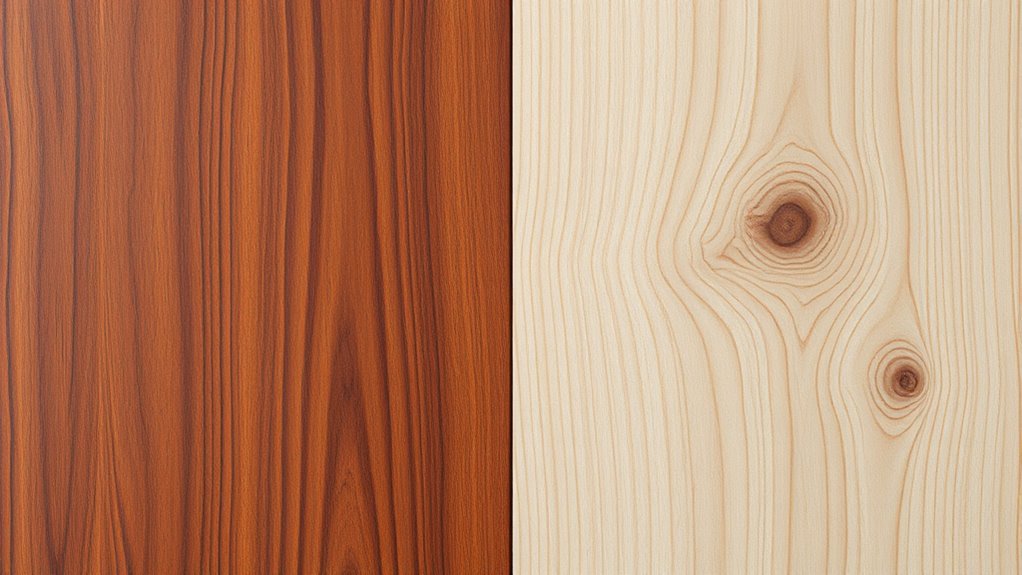
Hardwoods and softwoods differ noticeably in their appearance and aesthetic appeal. Hardwoods often display bold, intricate grain patterns due to their complex cell structures with visible pores. Their growth rings are tightly spaced, creating detailed and varied textures that add visual interest. They are also associated with a greater variety of finishes and visual appeal, making them popular for high-end furniture and flooring. They tend to have darker hues, ranging from rich browns to deep, warm tones, which enhance their luxurious look. The surfaces of hardwoods are typically smooth and refined, polishing to a high sheen that highlights their natural beauty. Over time, hardwoods develop a rich patina, deepening their color and adding character.
In contrast, softwoods usually have lighter, more uniform colors—pale yellows or light browns—and simpler grain patterns. Their appearance lends itself to a clean, minimalist aesthetic, especially when stained or finished.
Common Uses and Practical Applications
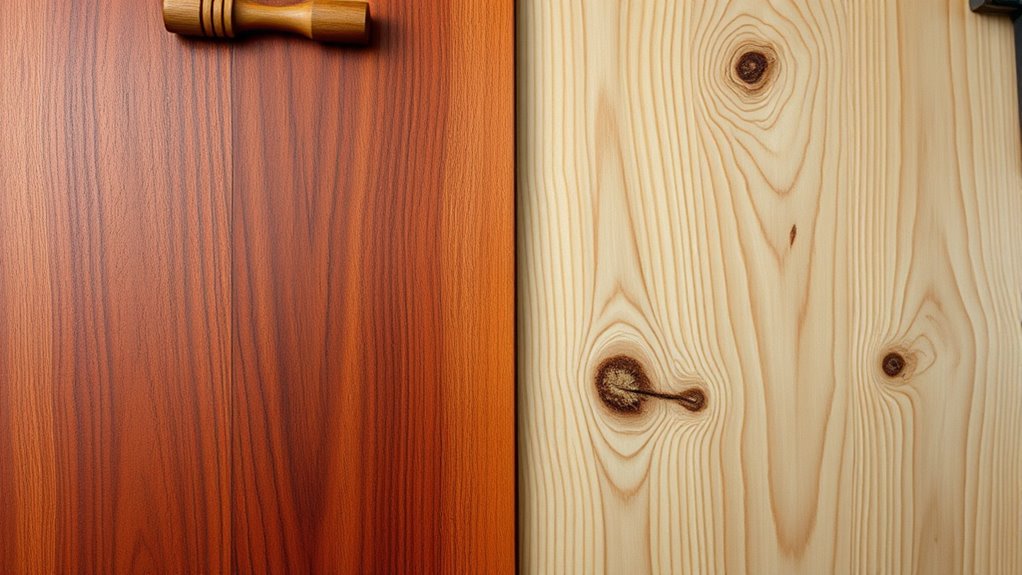
Softwoods are widely used in construction because they grow quickly and cost less than hardwoods. They dominate framing, roof trusses, and interior walls due to their affordability and fast growth.
Treated softwoods are excellent for outdoor projects like garden furniture and decking, resisting weather after treatment.
Softwoods are also key in producing engineered products like plywood, MDF, and fiberboard, which add versatility to building and cabinetry.
For flooring, softwoods are less common but can be combined with veneers for a budget-friendly look.
In furniture, softwoods are popular for basic pieces and DIY projects because they’re easier to work with.
Outdoors, softwoods often need chemical treatments for durability, but they remain essential for many practical, cost-effective applications across construction and craftsmanship.
Growth Rates and Environmental Impact
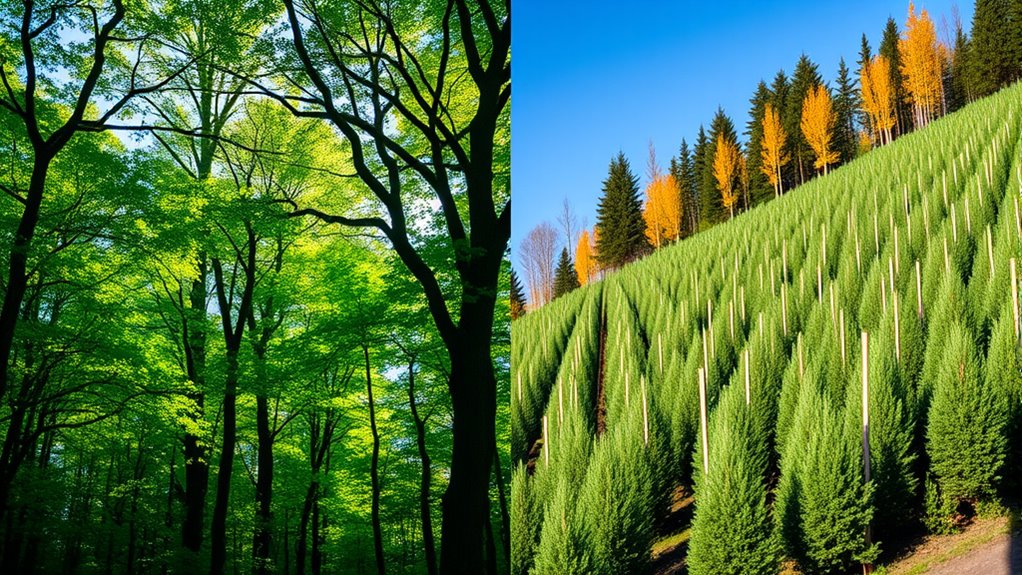
Because softwood trees grow much faster than hardwoods, they can be harvested more frequently, making them a highly sustainable resource. On average, softwoods grow about 75% faster, reaching maturity in 10 to 20 years, compared to 25 to 100 years for hardwoods. This rapid growth allows for quicker reforestation and more efficient land use. Environmentally, softwoods sequester carbon faster in the short term and are easier to replant, supporting large-scale forestry. Additionally, the influence of Ancient Hopi Tribe Villages demonstrates how natural surroundings can shape sustainable practices. Moreover, sustainable forestry practices play a crucial role in maintaining ecological balance while harvesting softwoods. These practices often include cost management strategies to optimize resource use and minimize waste. For example, innovations in reforestation techniques help ensure that softwood resources remain abundant without damaging ecosystems. However, hardwoods store carbon longer due to their durability, contributing to long-term ecosystem stability. Their slower growth supports biodiversity and soil health, though they require more water and nutrients.
Cost, Availability, and Sustainability

Are you wondering how the costs, availability, and sustainability of different wood types compare? Generally, hardwoods are more expensive than softwoods because they grow slower and require more labor to harvest. However, prices vary depending on species, volume, and market demand. Top 10 anime films can provide a cultural backdrop for understanding storytelling styles across different media, including woodcrafts used in set designs. Proper general ledger coding can also help track the costs associated with different types of wood and their sourcing. Softwoods like pine are usually more affordable and widely available, especially in regions with abundant forests. Meanwhile, hardwoods can be harder to source and costlier. From a sustainability perspective, softwoods are often replanted quickly, making them a sustainable choice, especially if sourced responsibly. Responsible harvesting is crucial to ensure that both types of wood remain environmentally friendly and support healthy ecosystems. Additionally, certification programs can guide consumers and businesses toward sustainably sourced wood.
Durability, Maintenance, and Workability
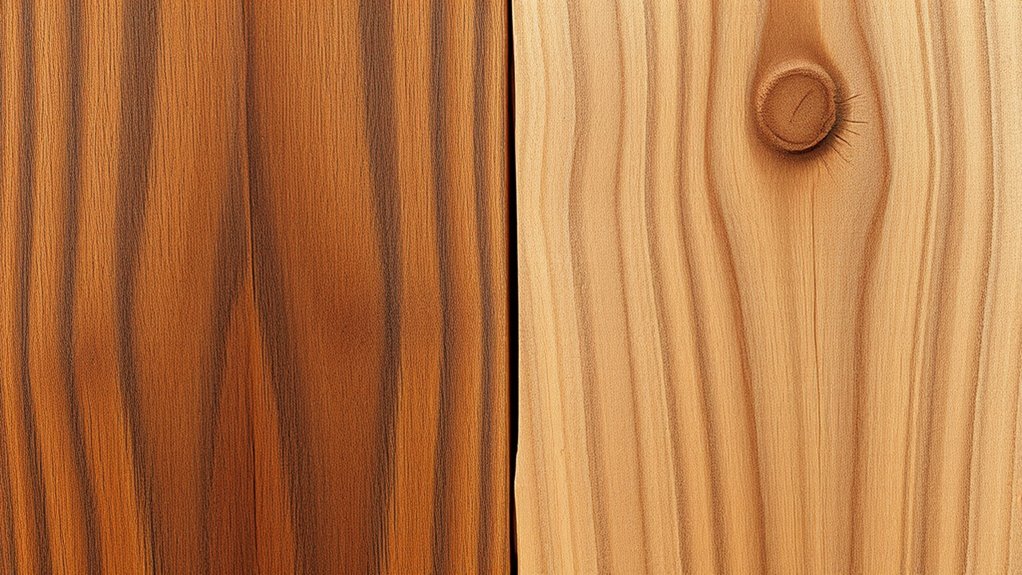
Hardwoods generally stand out for their superior durability, making them ideal for outdoor and high-wear applications. Their higher density provides better resistance to wear, impact, moisture, and environmental factors.
While softwoods are typically less durable due to lower density, some like Western Red Cedar are naturally resistant to rot and insects. Both types can weather to a silvery gray if left untreated, but softwoods often need treatment to improve durability outdoors.
When it comes to maintenance, hardwoods require less attention because of their natural resilience, but repairs can be tougher. Softwoods need more upkeep due to their susceptibility to decay and pests.
Workability varies: softwoods are easier to cut and shape, while hardwoods produce smoother finishes but demand sharper tools and more effort. Additionally, understanding self-watering plant pots can highlight the importance of material choice and construction quality for longevity and ease of use.
Choosing Between Hardwood and Softwood

Choosing between hardwood and softwood depends largely on your project’s specific needs and conditions. If your project involves high moisture, humidity, or heavy wear, hardwood is the better choice because of its strength and durability. Additionally, hardwoods often require less maintenance over time, making them suitable for high-traffic areas. Knowing heat pump noise levels can help you select materials that minimize disturbance in your living space.
For less demanding environments where cost and appearance matter more, softwoods are suitable—they’re generally more affordable, readily available, and easier to work with. Softwood panels may wear faster and need extra maintenance, while hardwoods offer longer-lasting performance. Understanding the different types of wood can help you choose the best material for your project’s specific aesthetic and functional needs. Ultimately, consider both the functional demands and visual goals to determine the best wood type for your project. Additionally, understanding payment processing can help you manage project costs effectively and ensure timely procurement of materials.
Frequently Asked Questions
How Do Hardwood and Softwood Affect Indoor Air Quality?
You might notice that hardwood generally improves indoor air quality because it emits fewer VOCs and doesn’t trap dust or pet dander.
Softwood, however, releases more VOCs like terpenes and formaldehyde, which can impact air quality negatively.
To keep your indoor air healthier, verify proper ventilation and choose hardwood when possible.
Softwood may require extra care to minimize VOC buildup and moisture-related issues over time.
Are There Health Risks Associated With Working With Hardwood or Softwood?
Working with wood dust is like walking through a fog of invisible dangers. You risk respiratory issues, allergies, and skin irritations from hardwood and softwood dust.
Prolonged inhalation can scar your lungs and cause chronic conditions, while chemicals in treated woods add another layer of hazard.
To protect yourself, keep dust levels below safety limits, wear proper gear, and ensure good ventilation—because your health’s worth more than the cost of safety.
Can Hardwoods and Softwoods Be Treated for Increased Resistance?
You can definitely treat both hardwoods and softwoods to boost their resistance. Treatments like preservatives, thermal modifications, and oils help protect against decay and pests.
Softwoods often need more frequent treatments, while hardwoods naturally resist damage better and may require less chemical intervention.
What Are the Environmental Impacts of Harvesting Hardwood Versus Softwood?
You should know that harvesting both hardwood and softwood impacts the environment through carbon release, habitat loss, and soil disturbance. Clear-cutting either type releases stored carbon and damages ecosystems, while selective logging reduces some impacts.
Softwood harvesting often results in higher productivity and potentially lower emissions per volume, but both methods can cause erosion, water changes, and biodiversity declines. Your choices in harvesting practices directly influence forest resilience and climate change mitigation efforts.
How Do Seasonal Changes Impact the Stability of Hardwood and Softwood Products?
Seasonal changes affect wood stability by causing expansion and contraction. You’ll notice hardwoods expand with high moisture and contract when dry, leading to gaps or warping if not properly acclimated.
Softwoods are even more sensitive, swelling more with humidity and moisture shifts. To prevent issues, you should control indoor climate, use proper installation techniques, and choose the right wood for your environment, ensuring your wood products stay stable year-round.
Conclusion
Now that you know the difference, choosing between hardwood and softwood is like picking the right brush for your masterpiece. Each has its own story, strength, and charm—waiting for you to bring your vision to life. Consider your project’s needs, sustainability goals, and budget. Remember, the perfect wood isn’t just about looks or cost—it’s about finding the one that speaks to your heart and stands the test of time.
